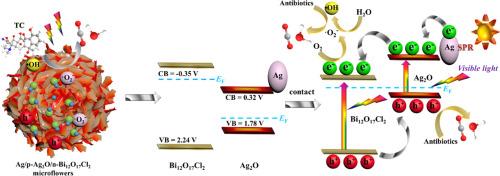用于光催化去除抗生素的花状 Ag/Ag2O/Bi12O17Cl2 异质结:质子效应和 p-n 异质结的协同效应
IF 11.2
1区 材料科学
Q1 MATERIALS SCIENCE, MULTIDISCIPLINARY
引用次数: 0
摘要
光催化废水净化技术的进步有赖于对优秀光催化剂的探索。本文成功构建了Ag/Ag2O/Bi12O17Cl2的新型花状等离子体p-n异质结,用于在可见光下高效净化抗生素废水。等离子体效应和p-n异质结的协同作用促进了光诱导载体的分离和利用,产生了充足的活性物质,从而促进了催化盐酸四环素(TC)分解反应。优化后的Ag/Ag2O/Bi12O17Cl2异质结的TC去除率分别是单一Ag2O、Bi12O17Cl2和Ag2O/Bi12O17Cl2的12.6倍、3.2倍和2.3倍。光诱导的h+、·O2−和·OH是光催化反应的主要贡献者。提出了TC可能的降解途径,并对中间体的毒性进行了评价。这项工作为环境净化等离子体p-n光催化剂的设计提供了见解。本文章由计算机程序翻译,如有差异,请以英文原文为准。

Flower-like Ag/Ag2O/Bi12O17Cl2 heterojunction for photocatalytic removal of antibiotics: Synergetic effect of plasmonic effect and p–n heterojunction
The advancement of photocatalysis techniques for wastewater purification relies on the exploration of outstanding photocatalysts. Herein, a novel flower-like plasmonic p–n heterojunction of Ag/Ag2O/Bi12O17Cl2 was successfully constructed for efficient purification of antibiotic wastewater under visible light. The synergetic effect of plasmonic effect and p–n heterojunction facilitates the separation and utilization of photo-induced carriers for creation of ample reactive species, thus boosting the catalytic tetracycline hydrochloride (TC) decomposition reactions. The TC removal rate of the optimized Ag/Ag2O/Bi12O17Cl2 heterojunction is 12.6, 3.2, and 2.3 times that of single Ag2O, Bi12O17Cl2, and Ag2O/Bi12O17Cl2 respectively. The photo-induced h+, ·O2− and ·OH are confirmed to be the major contributors in the photocatalytic reactions. Also, the possible degradation pathways of TC are proposed, and the toxicity of the intermediates are estimated. This work offers insights into the design of plasmonic p–n photocatalysts for environmental purifications.
求助全文
通过发布文献求助,成功后即可免费获取论文全文。
去求助
来源期刊

Journal of Materials Science & Technology
工程技术-材料科学:综合
CiteScore
20.00
自引率
11.00%
发文量
995
审稿时长
13 days
期刊介绍:
Journal of Materials Science & Technology strives to promote global collaboration in the field of materials science and technology. It primarily publishes original research papers, invited review articles, letters, research notes, and summaries of scientific achievements. The journal covers a wide range of materials science and technology topics, including metallic materials, inorganic nonmetallic materials, and composite materials.
 求助内容:
求助内容: 应助结果提醒方式:
应助结果提醒方式:


